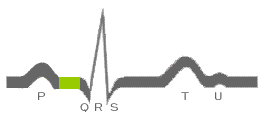There is no wave form obvious on the body surface electrocardiogram during the interval from the end of the P wave to the onset of the QRS complex. This is eferred to as the PR segment and is shown here in green. However, it iks important to recognize that during this interval, atrial cells are repolarizing and cells within the conduction system are depolarizing. The absence of any obvious deflection on the ECG is due to the recording characteristics of the ECG machine, such as its sampling rate, frequency response, and filter settings and the fact that the mass of tissue involved is on the endocardial surface and is relatively small.

